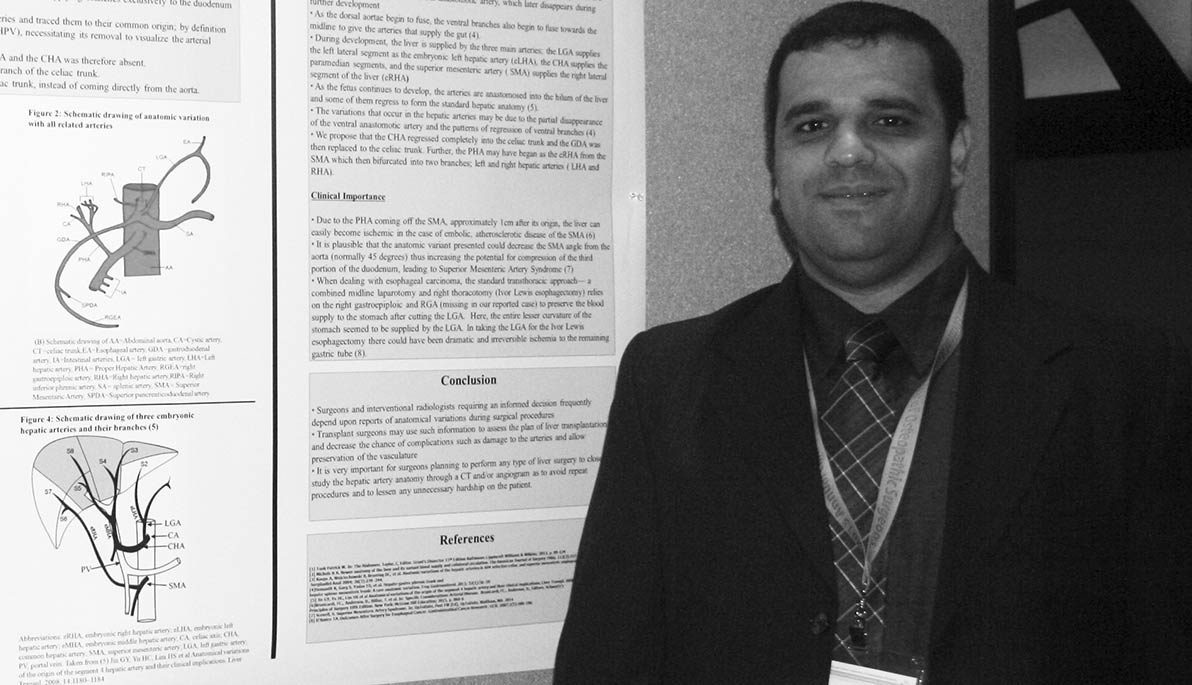News
NYITCOM Student Discovers Rare Arterial Condition in Anatomy Lab
February 19, 2016
An ordinary lab session led NYIT medical student Anas Alakkam to discover a rare condition and publish his research findings in a prominent journal for surgeons and radiologists.
Alakkam, a third-year student at NYIT College of Osteopathic Medicine (NYITCOM), discovered the condition during a routine cadaver dissection as part of the medical school's first-year anatomy course.
While dissecting the body of an 84-year-old man, Alakkam found that a major artery supplying most of the liver's blood originated from a different location than usual. In addition, one artery was missing and other smaller arteries also branched off in different directions. The arterial variations—found in less than 1 percent of the population—probably occurred during development but apparently did not affect the man's life. However, if he had undergone surgery on that area of his body or had received a liver transplant, physicians would have been presented with a more complex procedure than expected.
Such arterial variations are not found in textbooks or taught in class, spurring Alakkam to research the case with NYITCOM Assistant Professor Gregory Saggio, D.O., and former anatomy chair Robert Hill, Ph.D. The trio subsequently co-published their findings in the journal Surgical and Radiologic Anatomy. Alakkam won the student poster presentation award in general vascular surgery at the 2015 American College of Osteopathic Surgeons Clinical Assembly in Chicago.
"The research is special because it has rarely, if at all, been witnessed and reported," said Alakkam. "Reporting our findings is important because it makes surgeons aware of such a possibility and decreases the element of surprise and complications when they encounter such a patient."
Saggio, a former surgeon at Kennedy Memorial Center in New Jersey, said that while surgeons routinely perform pre-surgical scans and tests, having a case study available on an anatomic variation increases their knowledge and helps avoid potentially devastating complications.
"Transplant surgeons may use such information to assess the surgical plan prior to and during liver transplantation," said Saggio.
The spur-of-the-moment discovery also taught another lesson in planning: it showed Alakkam the process of publishing lengthy research. Although he has co-authored several publications and was lead author on two published abstracts as a research associate at the University of Illinois at Chicago, the arterial anomaly research is his first published study as lead author.
"It felt wonderful," said Alakkam of the journal's acceptance notification. Though the process of publishing a paper for the first time posed some challenges, he ultimately found that "all the time and effort put into the drafts was very rewarding and fruitful."
Alakkam is a native of Syria and part of NYITCOM's Émigré Physician Program. He recently began his family medicine rotation at Good Samaritan Medical Center in West Islip, N.Y. He has already completed rotations in internal medicine, pediatrics, and obstetrics/gynecology at Good Samaritan, and in psychiatry at Brookhaven Hospital.

_Thumb.jpg)


